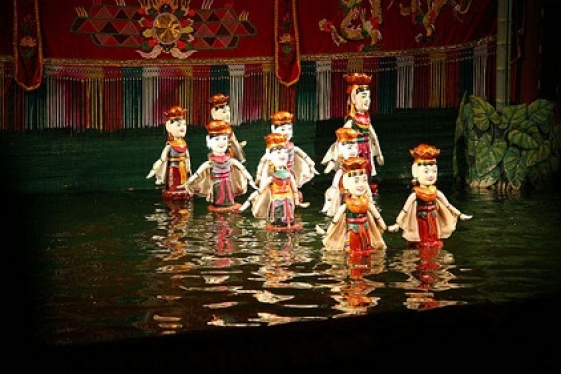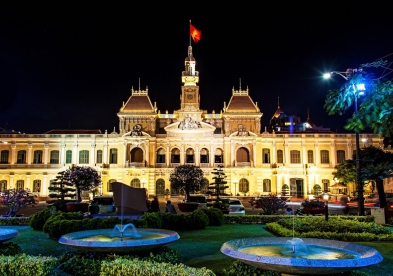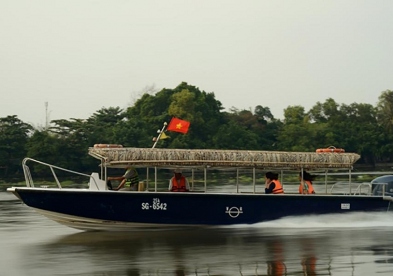Van Phuc Silk Village
Situated on the bank of Nhue River, about 10km southwest of Hanoi Old Quarter, Van Phuc silk village is renowned for its traditional weaving and premium quality silk products.
.jpg)
t the age of more than 1,200 years, Van Phuc is proud to be the most ancient silk village which provides the best silk in Vietnam. Visitors to Van Phuc village will be impressed by typical manner of an ancient village in the north of Vietnam with banyan tree, well, communal house, and the sound of power-looms everywhere. Walking on the main road in Van Phuc, tourists will be lost in the world of silk with various products like shirts, ties, crafts, dresses… made of silk available in the village.
For a long period of time, silk was considered as extremely precious handwork which was only used to tailor Royal members' and aristocrats’ dress. The special beauty of Van Phuc or Ha Dong silk was inspiration for many Vietnamese poems, songs and movies (see The White Silk Dress, one of the 5 most outstanding Vietnamese movies).
In Nguyen dynasty time, Van Phuc silk was brought to Hue imperial citadel to make dress for royal members. Between 1931 and 1932, Van Phuc silk was on display in international exhibitions for the first time in Marseille, then Paris and was highly appreciated and preferred by the French. From 1958 to 1988, Van Phuc silk mostly was exported to Eastern European market, and since 1990, it has been known widely in many countries all over the world.
.jpg)
Van Phuc silk has been known for its smooth, light weight, and elegant appearance. Especially, a traditional kind of silk called Van Silk made in Van Phuc make the wearers feel cool in summer and warm in winter. Today, to satisfy various demand for silk of the market, Van Phuc silk producers have expanded their silk and garment goods like embroidered silk, , wrinkled silk, double layers and more colors for silk products.
Many families in Van Phuc open their own shops on the main road of the village; create a “town of silk” that sell eye-catching and high quality silk products. Tourists may buy available nice souvenir and clothes in the shop, or select the most suitable materials to then get customized products. The sellers are very friendly and can speak a little English and French to communicate to foreign tourists.
Nowadays, although the weaving has been mechanized for higher productivity, there are still simple manual looms in some houses in the village which help tourists contemplate the genuinely traditional Vietnamese way of making silk.
How to get there
Tourists can join a tour to Van Phuc village available in travel agencies, or visit Van Phuc on their owns by car, motorbike, or catch the local bus 02, 21 then walk 500m to reach the village.
Tourists should travel south west out of Hanoi center on Nguyen Trai road until reach the border of Ha Dong district, then turn right and drive about 3km to reach the village.
See more
-
.jpg)
Bach Thao Park
Bach Thao means “hundreds of plants” and like its name, the park is one of the few green areas in the increasingly industrialized city of Hanoi. Bach Thao Park or...
-
.jpg)
Hoi An Museum of History & Culture
Where the Thu Bon River flows directly into the East China Sea, Hoi An was once one of the major Asian trade hubs. From the 16th to 18th century merchants visited from across...
-

Water Puppet Shows in Ho Chi Minh
Traditional Vietnamese Water Puppet Shows remain one of the cultural draws for most travellers to Ho Chi Minh City.
-

Visiting Prince of Bac Lieu House
If people have a chance to travel to Bac Lieu , they are difficult to ignore an attractive palace, Prince of Bac Lieu House. The house was designed by French engineer and...
-
.jpg)
Tu Duc Tomb
Located in a narrow valley in Duong Xuan Thuong Village, 8km from Hue City, Tu Duc Tomb is considered as one of the most beautiful and picturesque and largest works of...
-

Phong Nha - Ke Bang National Park
Mother land gives Quang Binh a spectacular and pristine landscape, Phong Nha – Ke Bang national park. It is the harmony of the primeval forest and Son River, along...
-
.jpg)
Bac Ha market
Located about 76 km from the train station, Bac Ha is a remote district of Lao Cai province. Bac Ha market which takes place every Sunday is famous for the originality and...
-

Ho Chi Minh City Zoo & Botanical Gardens
Founded more than 100 years ago, Ho Chi Minh City Zoo and Botanical Gardens (aka Saigon Zoo and Botanical Gardens) are listed as one of the oldest zoos in the world, opened...
-
.jpg)
Long Bien Bridge
If Hoan Kiem Lake with special green water and the red bridge named The Huc is the symbol of an elegant and charming ancient city; Red river and Long Bien bridge may be seen...
-

Thu Le Park
Also known as Hanoi zoo, Thu Le Park is a popular place for families, especially those with young children.
Destinations
Most popular tours
-

Cu Chi Tunnels & Ho Chi Minh City
Price from: 110 US$
-

Cu Chi Tunnels by Speedboat
Price from: 84 US$
-

Visit Bat Trang & Le Mat Traditional Village
Price from: 25 US$
-

South Vietnam Hideaway
Price from: 1.710 US$
Business info
Vietnam Local Guide
- Address: 18th Floor, VTC Online Tower, 18 Tam Trinh Str.,Hai Ba Trung Dist., Hanoi, Vietnam
- Email: info@vietnamguider.com
- Phone: (+84) 0904989890
- Hotline: (+84) 0904989890